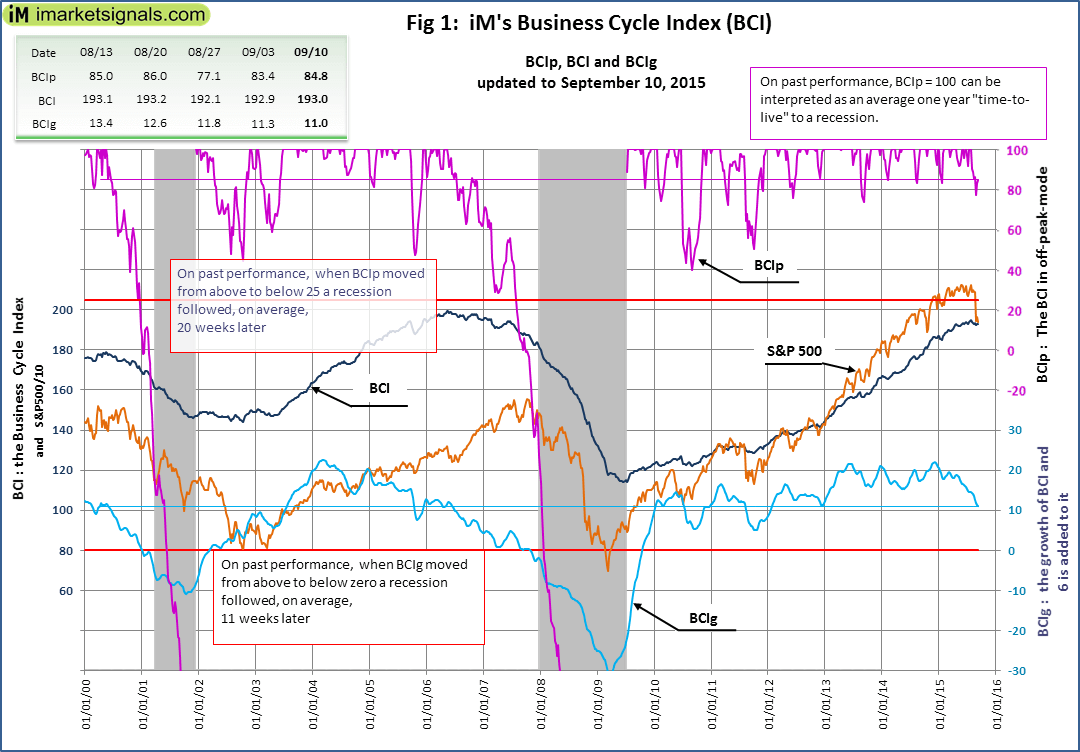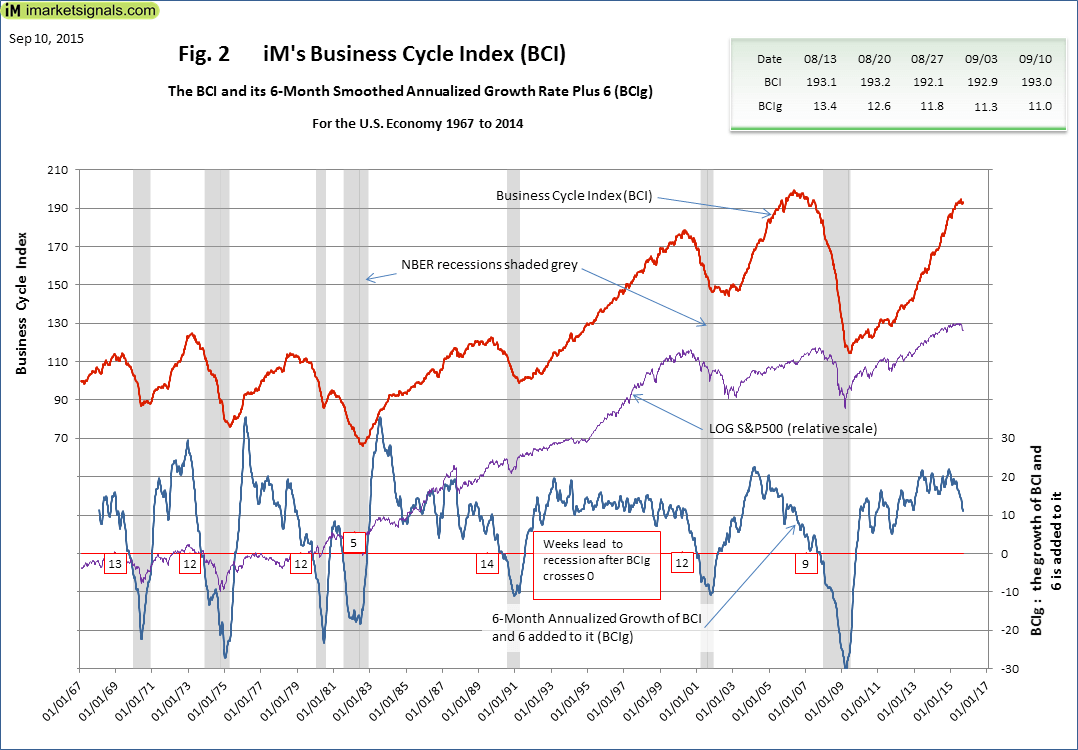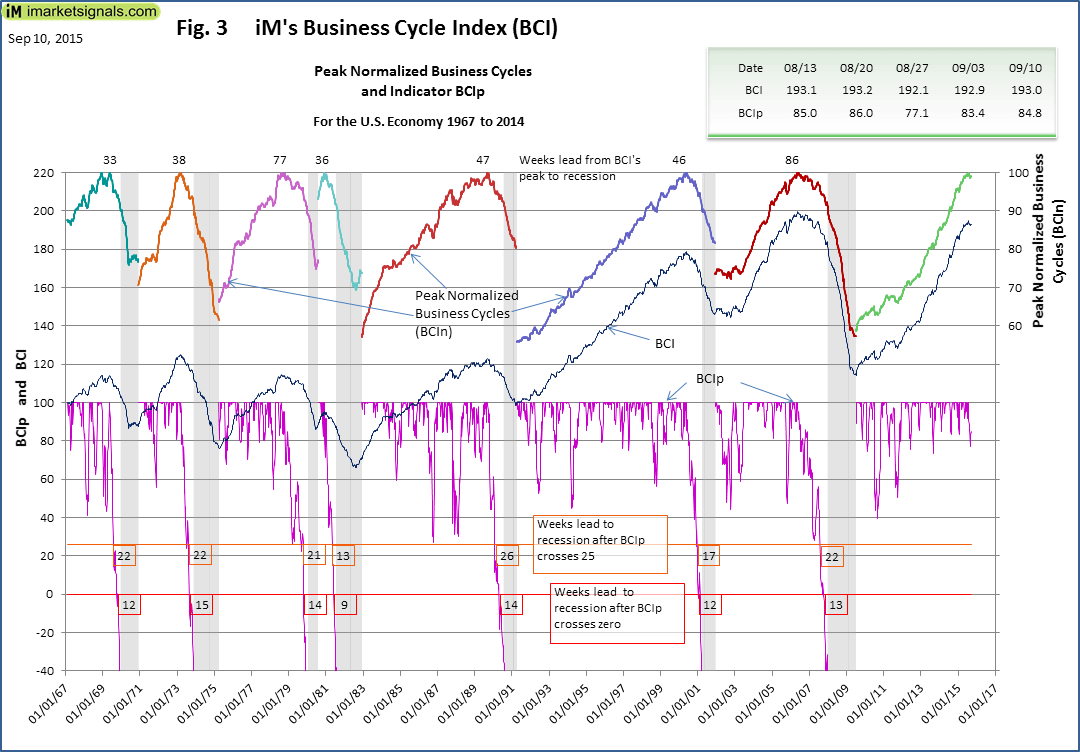Knowing when the U.S. Economy is heading for recession is paramount for successful investment decisions. Our weekly Business Cycle Index (BCI) would have provided early reliably warnings for the past seven recessions.
The BCI at 193.0 is marginally higher than last week’s 192.9. However, the 6-month smoothed annualized growth BCIg at 11.0 is lower compared to last week’s 11.3, and BCIp at 84.8 indicates that for this business cycle the BCI is lower than its previous peak.
Figure 1 plots BCIp, BCI, BCIg and the S&P500 together with the thresholds (red lines) that need to be crossed to be able to call a recession.
It is now the 21st week that BCIg has declined from the previous week’s value. Since 1967, only on eight prior occasions has such a long declining run been observed. On four of those occasions, the economy was in recession and BCIg in negative territory. The other four occasions the declining streak lasted for 32, 27, 25 and 20 weeks and only the first being a harbinger to a recession.
| Date | BCI | BCIp | BCIg | Duration and Outcome |
| 05/03/73 | 122.5 | 66.6 | 17.1 | 32wks, and BCIp signaled on 7/5/73 a recession. |
| 07/08/76 | 93.2 | 84.8 | 20.4 | 27wks, no recession followed. |
| 02/21/80 | 100.3 | -108.0 | -7.0 | In recession. |
| 08/20/81 | 85.2 | -75.2 | -5.8 | In recession. |
| 06/28/84 | 92.5 | 93.4 | 14.3 | 25wks, no recession followed. |
| 10/18/90 | 106.2 | -127.8 | -8.1 | In recession. |
| 09/30/04 | 174.5 | 100.0 | 14.0 | 20wks, no recession followed. |
| 09/11/08 | 154.1 | -282.2 | -13.4 | In recession. |
| 09/03/15 | 192.9 | 83.5 | 11.3 | No recession signaled (BCIp and BCIg too high) |
The BCI uses the below listed economic data, and combining the components for the index in “real time”, i.e. the data is only incorporated into the index at its publication date.
- 10-year treasury yield (daily)
- 3-month treasury bill yield (daily)
- S&P500 (daily)
- Continues Claims Seasonally Adjusted (weekly)
- All Employees: Total Private Industries (monthly)
- New houses for sale (monthly)
- New houses sold (monthly)
The 6-month smoothed annualized growth rate of series is a well-established method to extract an indicator from the series. We use this method to obtain BCIg, i.e. the calculated growth rate with 6.0 added to it, which generates, on past performance, an average 11 week leading recession signal when BCIg falls below zero. Further, the index BCI retreats from its cyclic peak prior to a recession in a well-defined manner allowing the extraction of the alternate indicator BCIp (and its variant BCIw) from which, on average, 20 week leading recession signal is generated when BCIp falls below 25. A more detailed explanation/description can be found here and weekly updates are sent by email to subscribers of iMarketSignals (no paid membership is required). Also, the historic values can be downloaded from iMarketSignals as an MS excel sheet.
Figure 2 plots the history of BCI, BCIg, and the LOG(S&P500) since July 1967, and Figure 3 plots the history of BCIp, i.e 46 years of history which include seven recessions, each which the BCIg and BCIp managed to indicate timely, the weeks lead to a recessions are indicated on the plots.



